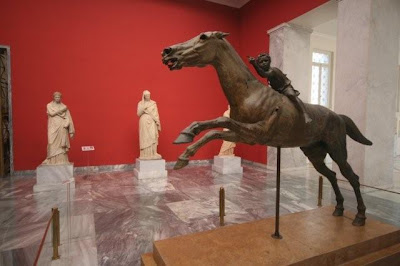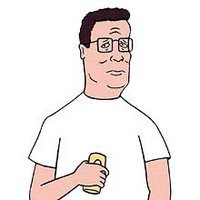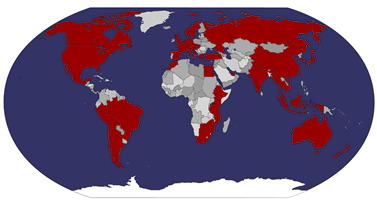Last full day in Istanbul starts with a visit to the Turkish and Islamic Arts Museum adjacent to the Hippodrome. 5L entry then up the staircase into the stone courtyards of the Ibrahim Pasha Palace.

The collection has some beautiful calligraphy, decorated pottery, and metallic and stone work. I have to say it is the facet of Islam that I admire the most – as Muslims were (and are) not allowed to depict images of their prophets, they turned to patterns and calligraphy. Note that there’s nothing in the Koran to prevent non-Muslims from portraying anyone – as usual the recent terrible events connected with the Danish newspapers were the realm of the misled and mis-informed. How many of those angry about the cartoons saw them (I downloaded them immediately of course), how many around the world read the Satanic Verses before making their mind up? It’s important to stick to a moderate path but also to question what you are taught and make your own mind up, a lesson which those involved in extremism of any kind usually forget.










This museum also has carpets. More carpets than my limited interest could sustain in fact.

This is apparently the "richest collection of carpet art in the world", which has resulted in the place being nicknamed the "Carpet Museum", and much "serious research on carpet art" is conducted here. How does one appreciate carpets? Stand in front of them and admire for a while, like a work of art? Sit on them and have a picnic (I suspect the guards would not condone interacting with the "art" in this way).
Next across to the Sulemaniye Mosque, one of the other biggies.

It turns out to be under restoration so most of the inside is sectioned off, but outside there is a graveyard, which is interesting, I don’t think I’ve ever seen Islamic graves before – they have inverted conical stones at either end of the coffin, very strange. Now I come to think about it, apart from some rather impressive mausoleums, I’ve never seen Islamic graveyards anywhere. What do they do with those who didn’t make sultanate of a large empire, they must put them somewhere?!

There is also the mausoleum of Suleman the Great himself, and why not, it’s his mosque after all.

He has plenty of other sultans to share his resting place with though, unlike his chief concubine, who has almost as grand a mausoleum almost to herself!

Down to the river via a slightly random route (okay I was lost), I cross the traffic-laden Ataturk Bridge,

handing a shoe cleaner a brush which he had dropped by accident. By way of thanks he insists despite my repeat refusal to clean my sandals, which are clean already thank you very much. He scrubs the leather with a toothbrush-like thing and an unspecified clear liquid, possibly water. Great, thanks for wetting my sandals. Then he mentions his son who needs an operation etc. Oh goodness, here we go. I tell him, quite truthfully, that I have no change.
I’m heading this way to find a hamam, which turns out to be quite a challenge as the map is, shall we say, slightly inaccurate in how it portrays roads. In the end, though, I find the place, not far from where it’s supposed to be.
Buyuk HamamThere are lots of people on the web looking for a genuine non-touristy hamam experience. I liked the response of one Istanbul resident, which went something along these lines: “There is no such thing as a non-touristy hamam – we have showers at home these days, so for most Turks hamams are as much a tourist experience as for foreigners”. Good point! Well, that said, there are more “commercial” ones than others, and I head to one that TimeOut suggests is fairly basic, the Buyuk Hamam in Potinciler Sokak, in Kasimpasha, north of Ataturk Bridge. The best way to find it is to look for the mosque on Bahariye Caddesi – the bath is literally beside the mosque at the back.
So what is a hamam? It’s the famous (infamous?) Turkish bath – the steamy rooms with hairy moustached men sitting about or getting scrubbed by other hairy moustached men. Again, I was of two minds as to whether to visit one (I still have memories of Seamus’ stag in Budapest when his brother “accidentally” took our group of a dozen chaps to a gay-only establishment) , but Mie told me I had to do so. I’ve also been feeling like I’m about to come down with the flu, I have that achy feeling, and that’s surely not good if I’m going for the full violent massage etc. Ah well, when in Rome…
There are two entrances, one for women and one for men. Not wishing to make a scene, particularly in light of the scope for confusion which my hair length provides, I wait a moment, hoping to see someone come in our out of either entrance, but no luck, so I ask, and am pointed in to the entrance nearest the mosque. Should have guessed! Next door at the cafes where dozens of men sip tea, I spot a table with four foreigners looking distinctly British and very pink in the face, I assume they’re recovering!

Inside they are friendly enough despite not speaking English. I’m shown a price list which shows 15 for the hamam, 7 for massage and 5 for scrub. Hmmm, those numbers might not be exactly correct, but the whole package came to 25L plus a tip for one’s torturer. First, shoes off and plastic slippers on (told you this was a basic place – no nice wooden clogs here). Then a little changing room place which I could lock, so leave bags in there and get naked except for a tea-towel affair to preserve modesty. They let you keep your key round your wrist, but presumably they have a second key anyway, so best not take many valuables along. From here, I’m sent across into the hamam itself. I potter about, not quite sure the drill, and it’s quite empty so there aren’t too many people to follow. There are lots of stone rooms, all with Islamic-style arches, light from the holes in the ceiling (covered with glass or plastic). Most rooms have many stone basins with taps around the edge.
I find the sauna, and head in. There are a couple of chaps talking, and a third in the corner. I sit and relax. It’s so cold outside that it takes a while for me to start sweating – got to defrost first!! The two chaps leave, so it’s just me and a moustached chap. We nod, and he asks where I’m from. He doesn’t really speak English, but communicates that he plays the trumpet, and has done so in Paris and New York. He then indicates that it’s hot and starts masturbating. Yep, you read correctly. Is this normal hamam behaviour? Anyway, I indicate with frowns and sign language that I’d prefer him to refrain from this for now, to which he counters that it’s hot in here, so this is what he wants to do. He does stop though. Luckily soon after I’m saved by my hamam chap collecting me for my scrubbing.
I’m lead round to one of the basins, where I sit and my chap, Mr Ishman, dons his brillo-pad glove and starts removing my skin, in between testing whether my hair is super-glued to my scalp. This goes on for some time, though to be honest it’s not quite as bad as I had been expecting from the shade of pink of the foreigners outside. In between scrubbing buckets of water are dumped on to me to rinse. At the end, he goes round to a few different basins scooping up a large bucket of water and pouring that on me. One of the scoops is quite cold, very refreshing after all the hot water.
Next up, massage. These take place in the central room, on a large flat stone area which is so hot that they put another tea-towel thing down for you to lie on, which the heat still comes through. On my back first, and he endeavours to move all matter in my leg, blood, muscles, bones etc, down to my foot, before going to work on crushing my ribs then snapping my arms off. Time to flip over, when my back receives a similar assault, then he starts twisting my arms and legs into unnatural positions then sitting on them. I think I must have been making a few wheezing noises as he winded me, but I shook his hand, smiled and thanked him nevertheless.
All done, and time to head out to my room and dry plus change back into my clothes. Overall it wasn’t as brutal as I was expecting, especially as I have been feeling a bit flu-ey and achy today. I round off the experience with tea outside, from the traditional glass cup that Turks like their tea in. 50cL.
 The Pera Museum and its Excitingly-Decorated Lift
The Pera Museum and its Excitingly-Decorated LiftUp the hill, I pass the now-closed Pera Hotel, which reminds me – I had wanted to visit the Pera Gallery. I ask a nearby parked taxi where the Pera Gallery is. He points at the hotel. Museum, I ask? He indicates that it’s closed. Just as well I don’t trust him, as another nearby hotel points me not 30m away, where the gallery is alive and open in a restored historic building.

The gallery includes many paintings by Western artists of Ottoman times – especially 18th to 20th centuries, including those of the usually unseen harem women on their excursions.

Other interesting exhibitions included one on Anatolian Weights and Measures and the beautiful Kütahya Tiles and Ceramics collection, something normally I wouldn’t have the faintest interest in, but for the gorgeous art and patterns with which those in this collection are decorated.

I strongly recommend the Pera Museum as a must in Istanbul. They also have spotless toilets and nice lifts:
 Istiklal Caddesi
Istiklal Caddesi
Istiklal Caddesi is the Oxford Street of Istanbul, but unlike London it’s pedestrianised – as London will surely be eventually, presumably once Crossrail is running in 2090 or so (invite the Chinese over, they’ll have it completed in about 9 months! – Plus we could pay them with the public tax money that Ken Livingstone currently blows on private polling for his own political purposes with MORI – see
here.

The streets are heavy with crowds on this Sunday afternoon. Shops vary from international chains – Starbucks, Topshop etc, to local Turkish clothes, books, pharmacy and other shops. A single tramcar, jammed full with locals, runs the length of the street every ten minutes ago or so.

I follow the street to Taksim,


where I cut down the hill, passing small smoky places with old men playing cards, to near Istanbul Modern to take the tram back.
In the evening, with hardly any money left, I end up having a McDonalds Kofteburger, one of a couple of localised dishes available, then home to channel surf the 761 channels I apparently have access to looking for the England France 6nations rugby game. No sign of it, so I enjoy France vs England in the Stadt de Paris by clicking refresh on the webpage of the BBC 606 Forum page. Not the most exciting medium, it has to be said, but still, the game went well, and we end France’s chances of a Grand Slam! That’s the important thing!
 Istanbul
IstanbulI’ve spent an expensive but fascinating few days in Istanbul, and surely will return, especially with Easyjet and BA both flying down here, meaning cheap fares. There’s so much to see and do – I almost ended up in a panic reading the TimeOut guide – my natural instinct is still to try to cover off everything, and this was just not going to be possible in the time I had to spend. It’s been nice staying in the centre, despite the cost - every time I pass the Hagia Sophia and Blue Mosque I am in awe, and even after four days walking to Sirkeci to leave Turkey, I paused and admired the scale and beauty of both buildings.
Apparently lots of Istanbul’s historical sites have never excavated, which bodes well for future interest, and I suspect part of the reason is that there’s so much to go on already without digging! One aspect I’ve missed out on is dining, bars and music – being on my own and trying to limit expenditure I’ve been a bit spendthrift on everything except admission fees. When I have a job and return for a long weekend this will be corrected! Parting note - in Turkey it seems they don’t write the expiry date of food, they write when it was made. Either that or all the bread in the local supermarket near me has been really old!
As I leave Antique Hostel, they tell me Spurs have beaten Chelsea too! What a day!
Turkey to Greece by TrainAt Sirkeci, my train is waiting on platform 1 as expected. I find I’m sharing a room with a Greek chap, which he clearly wasn’t expecting. The guard says there is plenty of space and I can take another room, though refuses to be drawn on the relatively simple question of which other rooms are actually free. I move next door and wait for people to show up, but no one does. Later I realise how preposterous it was that the idiot ticket-seller had put us in the same room – in our carriage of, say, a dozen rooms only 3 or 4 were in use, and there were two or three carriages.
These are the old French carriages, which are apparently not as nice as the new Turkish ones, but I like their design – they have a two level cabin design, so I’m now in an upper cabin, with the two beds both high, near the ceiling, sitting on the two low cabins to either side of mine. Below between the beds I have a comfy sofa, table concealing a washbasin, and lots of hidden cupboards and things. We set off bang on time, rolling at first extremely slowly out of town, following the city walls. The conductor comes round and takes all but one of my many tickets, which leaves me feeling slightly cheated. We hit the borders in the early hours so I might try to get some sleep.
I do get off to sleep, and as is always the way, just as I’m sleeping nicely we stop at the border and are rudely awakened. However, things are easier these days – one need not alight from the train – the Turkish and Greek sides both now just collect your passports from your room and return after an improbable length of time having just rubber-stamped the relevant page. Up to this stage we seemed to be on time, but in the morning we arrived into Thessaloniki about three hours late! On a five hour run! Where on earth did we lose all that time? Anyway, this meant missing my connection, and so I purchased a ticket for the 11:40am train, about 45 minutes to wait. Second class full, ah well, what is one to do? 50 euros for first-class on Intercity 71. This train is also late – about 30 minutes, so we should, assuming no further time is lost, arrive in Athens about 5:30pm.
First impressions of Greece? Not much of a change from Turkey. Less mosques of course. Plenty of EU symbols all over the place. And the alphabet!! Goodness me, this is going to be hard work! When Roman letters are substituted for foreign characters that is fine, but in Greek you have Roman characters being substituted for Greek letters which are also Roman characters, so h becomes E, E becomes N etc, it’s very confusing. The best hope you have of understanding any words is if a few of the letters are the same and the length of the word matches. Athens is AƟHNAI. Yucks!



































































